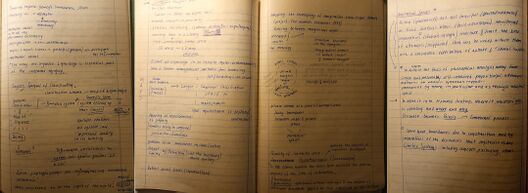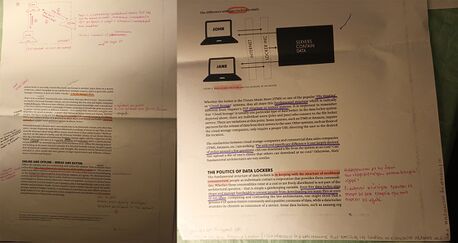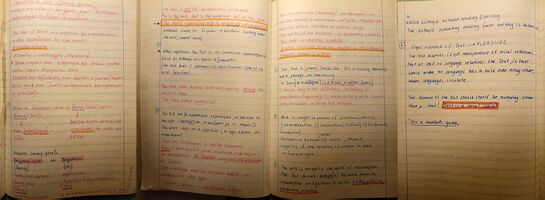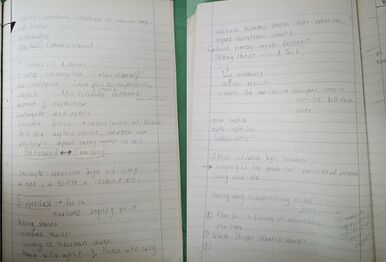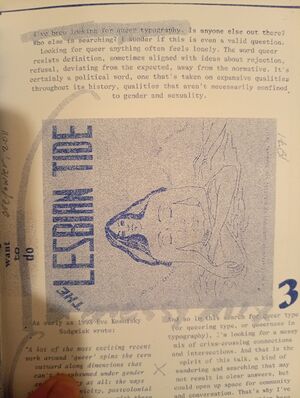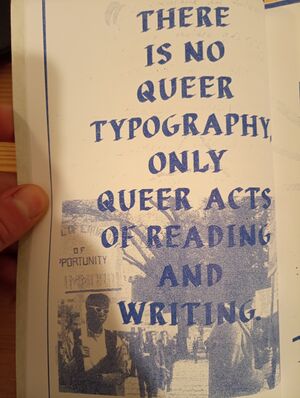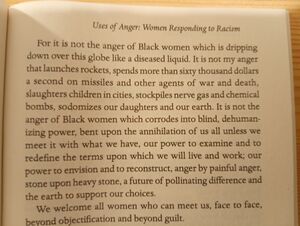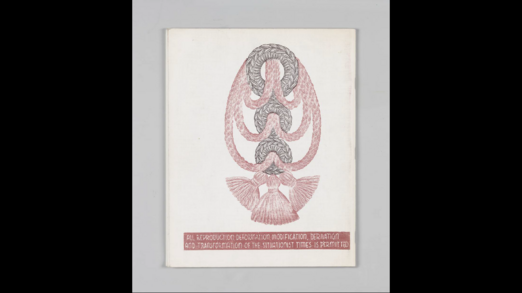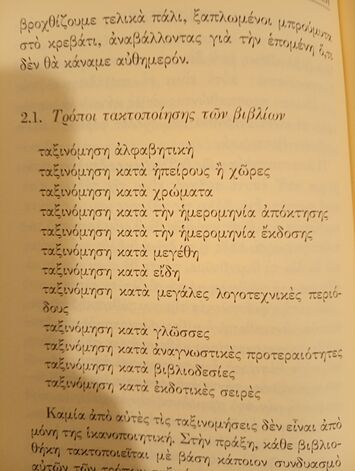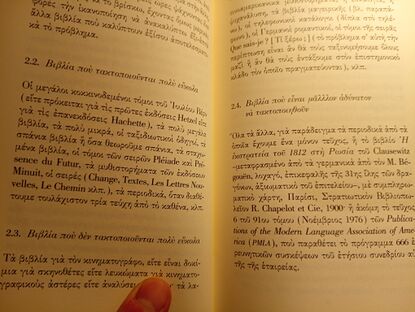The Methods, the Readers, the Texts
W H Y | W H A T | H O W
HOW DO WE LIBRARY THAT???
Bootleg Library
https://hub.xpub.nl/bootleglibrary/shelf/96
Mapping Beyond Dewey's Boundaries: Constructing Classificatory Space for Marginalised Knowledge Domains | Hope A. Olson
"Moving from silence into speech is for the oppressed the colonised, the exploited in those who stand and struggle side by side a gesture of defiance that heeals that makes new life new growth possible. it is the act of speech, stalking back that is no mere gesture of my words that is the expression of our movement from object to subject the "liberated voice.", Bell Hooks
The way we organize knowledge is essential part of the cultural memory
Sayers " manual of classification"
Classification scheme---> map of knowledge
Cornell's idea-- boundless system system defined by the limits post-structuralist
Multiple realities no system can represent reality in it's totallity
Η ταξινόμηση καταδεικνύει τη σχέση ενός κλάδου γνώσης με έναν άλλο
Σχέση χαρτογράφησης και ταξινόμησης ως κοινωνικές κατασκευές!
Maps consider to be the limits of the world
Distort all knowledge is infinite multi diamonds dimensionality into ε linear arrangement suitable for browsing list locations on shelves
Mapping as representations of property terrains belong someone
Quality of constructed space
Is the extent to which the index term reflects the precise content of the item of information. Pigeon holes performed without reference to the subjects of particular documents based on the structure of the system in comparison with co extensiveness which is dazed on the subjects of individual documents.
Rhetorical spaces(to deflect the folks Sofia Sophie call analysis away from singing and presumably self-contained propositional you terence's pronounced by no one in particular and as though neutral space)
Fictive φανταστικός but not fanciful φαντασιόπληκτος or fixed locations whose tacit territorial imperative structure and limited the kind of answers that can be voiced within them with a reasonable expectation of uptake and coral support.
--> to move it into textured locations where it matters who is speaking and where and why discourse becomes Poiesis (communal process)
Space have boundaries due to construction by imperatives of the discourses that construct them.
Limited systems including concepts excluding others.
This apparently neutral space is like postmodern theorist Henri Lefebvre transparent space which denies the existence of anything excluded from snapping because it appears to be all there is. "Transparent" space is the illusion that location is neutral' that mapping territory can be a 'true' representation of some a sense of reality as Brooks suggests. Space husband Aries and always includes and excludes something it cannot be neutral. Making the exclusions visible means identifying the space boundaries to allow recognition of what is outside those boundaries. It is identifying the implied opposite of a deconstructive binary opposition. It shows the constructed nature of the space. It moves the discourse into Texas locations word mothers who is speaking and where and why and where such monitoring bears directly upon the possibility of knowledge claims.
Poiesis a way of presenting experience reality that remains and alters it in the process
Classification remakes and altars information by constructing a particular context for it. Gathering scattering and juxtaposing topics in relation to each other.
The creation of classification creates the space in which some knowledges are central and others are peripheral.
Radical Tactics of the Offline Library (It's a numbers game) | Henry Warwick
Image Music Text (From Work to Text) | Ronald Barthes
From work to text
The Text is not to be thought of as an object that can
be computed. It would be futile to try to separate out
materially works from texts. I The difference is this: the work is a
fragment of substance, occupying a part of the space of books
the text is a process of demonstration, speaks according
to certain rules (or against certain rules);
(in a library for example), the Text is a methodologicalfi eld. the one is displayed (εκτείθεται), the other demonstrated
only exists in the movement of a discourse (or rather, it is
Text for the very reason that it knows itself as text); the
Text is not the decomposition of the work, it is the work that
is the imaginary tail of the Text; or again, the Text is
experienced only in an activity of production. It follows that
the Text cannot stop (for example on a library shelf);
its constitutive movement is that of cutting across (in
particular, it can cut across the work, several works).
2. In the same way, the Text does not stop at (good)
Literature; it cannot be contained in a hierarchy, even in a
simple division of genres. What constitutes the Text is, on
the contrary (or precisely), its subversive force in respect of
the old classifications. How do you classify a writer like
Georges Bataille? Novelist, poet, essayist, economist,
philosopher, mystic? The answer is so difficult that the
literary manuals generally prefer to forget about Bataille
who, in fact, wrote texts, perhaps continuously one single
text. If the Text poses problems of classification (which is
furthermore one of its 'social' functions), this is because it
expression from Philippe Sollers).
The word is a virus - Burroughs
https://www.youtube.com/watchv=KvOoR8m0oms&ab_channel=stereomusicvideo
“The word is now a virus. The flu virus may have once been a healthy lung cell. It is now a parasitic organism that invades and damages the central nervous system. Modern man has lost the option of silence. Try halting sub-vocal speech. Try to achieve even ten seconds of inner silence. You will encounter a resisting organism that forces you to talk. That organism is the word.”
Donna Haraway's response to Ursula Le Guin's Carrier Bag
Moya Davey, Fifty minutes
https://www.ubu.com/film/davey_50.html
Fugitive Libaries | Shannon Mattern
The Undercommons: Fugitive Planning & Black Study
She Unnames Them | Ursula K. Le Guin
Ursula K. Le Guin 1986 The Carrier Bag Theory of Fiction
Mutual Aid | Peter Kropotkin (1912)
Hyperworld | Ted Nelson
The Future of Writing
Paper Machines (Thinking in Boxes) | Markus Krajewski
Kleist ’ s idea is that communication partners need a catalyst to attain clarity about the knowledge to be expressed. What does the mere presence of an interlocutor achieve? “ The midwifery of thought ” — a term Kleist borrowed from Kant. Without a counterpart, intellectual bankruptcy looms, as in the case of Heine ’ s friend G., but with a partner, wealth beckons. It is no coincidence that early collections of analects and excerpts from all readings date from the same era as the paper banks of the sixteenth century.
According to Kleist, the human face serves as a sufficient source for inspiration; a look that conveys comprehension of a half-expressed thought is suffi cient. One could assume that looking at wooden drawers is hardly inspiring. However, substitute the “ interface ” between person and appara-tus for the “ human face ” — and substitute for the simple word “ gaze ” the word “ brush. ” For it is the light touch of index cards, the interplay with the silent interlocutor, that gives birth to a thought, prompting the inter-locutor to actually speak and provide “ witty responses ” after all, to use Kleist ’ s phrase. The box of index cards offers an interface that is more than just a stimulating sight, as the apparatus, upon the lightest touch, delivers keywords that stimulate the protagonist to further production of thought. Thus, a silent counterpart can grow into an actual interlocutor. The fact that the keywords offered seem by no means arbitrary is guaranteed by a widespread net of cross-references, for both partners. Bit by bit, during the course of their interaction, connections accumulate in the apparatus as a “ kind of second memory. ” 70 And this second memory gains a certain amount of independence if it intervenes in the thought process of its thoughtful user more thoroughly than Kleist suggested.
Exploratory Programming: Calculating and using Jupyter Notebook
Writing Machines (Technotexts) | N. Katherine Hayles
Why to use metaphor? μεταφέρω = bearing across
"denotes transfer of sense associated with one word to another. The transfer between a symbol (network of symbols) and a material apparatus. Symbol-processing machines we call computers. Material metaphor --> a term that foregrounds a traffic between words and physical artifacts. "
"Book as material metaphor but in fact it is an artifact whose physical properties and historical usage structure our interactions with in ways obvious and subtle."
list of MACHINES, TOOLS, THE MATERIALISATION
** "to change the physical form of artifacts is to change the act of reading, but profoundly to transform the metaphoric network structuring the relation of world to world.
To change the material artifacts is to transform the context and circumstances for interacting with the words, which inevitably change the meaning of the word as well. This transformation of meaning is especially potent when teh words reflexively interact with the inscription technologies that produce them"
----
Literary works that strengthen, foreground, and thematize theconnections between themselves as material artifacts and the imagina-tive realm of verbal/semiotic signifiers they instantiate open a window onthe larger connections that unite literature as a verbal art to its mate-rial forms. To name such works, I propose “technotexts,” a term that connects the technology that produces texts to the texts’ verbal con-structions. Technotexts play a special role in transforming literary crit-icism into a material practice, for they make vividly clear that the issueatstake is nothing less than a full-bodied understanding of literature.
All of the technotexts I discuss in this book could also be called hypertexts. Hypertext has at a minimum the three characteristics of MULTIPLE READING PATHS,CHUNKED TEXT, and some kind of LINKING MECHANISM to connect the chunks.
Writing (The future of Writing) | Vilem Flusser
Writing is an important gesture, because it both articulates and produces that state of mind which is called “historical consciousness.” History began with the invention of writing, not for the banal reason oftenadvanced that written texts permit us to reconstruct the past, but for themore pertinent reason that the world is not perceived as a process, “historically,” unless one signifies it by successive symbols, by writing.
If one examines certain Mesopotamian tiles, one can see that the original purpose of writing was to facilitate the deciphering of images.Those tiles contain images impressed upon them with cylindrical sealsand “cuneiform” symbols scratched into them with a stylus.
It may be shown through text analysis that the original pur-pose of writing, namely, the transcoding of two-dimensional codes into asingle dimension, is still there: every text, even a very abstract one, means,in the last analysis, an image.
The purpose of images is to mean the world, but they may become opaque to the world and cover it,even substitute for it. They may come to constitute an imaginary world that no longer mediates between man and the world, but, on the contrary, imprisons man. Imagination no longer overcomes alienation, but becomes hallucination, or double alienation. No longer are such images tools, but man himself becomes a tool of his own tools; he “adores” theimages he himself has produced. It is against this idolatry of images, as atherapy against this double alienation, that writing was invented. Theearly writers in our tradition—the prophets, for instance—knew this bycommitting themselves against idols and idol making. And so did Platowhen he announced his hatred of what we now call the “plastic arts.”Writing, historical consciousness, linear, rational thought were inventedto save humankind from “ideologies,” from hallucinatory imagination.
The purpose of writing is to mean, to explain images, but texts may be-come opaque, unimaginable, and they then constitute barriers betweenman and the world. (...)Such unimaginable explanations that mirror the structure of literate thought are existentially devoid of meaning, and in such a situation texts begin to constitute akind of paranoid library wall that triply alienates man from his world.
TECHNO-IMAGES
Un-/Learning Archives in the Age of the Sixth Extinction
https://wholelife.hkw.de/un-learning-archives-in-the-age-of-the-sixth-extinction/
"In thinking more about gardens as overlapping sites of history, legacy, and testimony, sustainable gardening systems, such as seed keeping and perennial plantings become metaphorical approaches to reconnecting with distant relatives and beloved homelands. Gardening is important, but seed saving is crucial. Gardeners frequently save seeds as an attempt to grow a better crop the next year, save money, and in order to trade with others. However, a seed holds more than its genetic logic. Seeds hold memory. For many, seeds are vessels for belief and hope.
Over the years, the gardener maintains a reciprocal exchange with plants—cultivating an intimate relationship to the earth, preserving memories of years before, and observing their own personal transformation in the process. How can gardening serve as a reminder of one’s cultural heritage and identity? How can seed saving make stories and traditions more widely known? How can seeds bring invisible legacies to the forefront? Seeds are relatives. They prompt discussions on creation, belonging, and heritage. Seeds are a living archive and therefore ask us how archives can become more participatory and serve as a transmission of history rather than being frozen or fixed. Seeds communicate physical, historical, and cultural relationships as they relate to agriculture. Some of us collect and carry seeds in an attempt to cultivate our “homelands” elsewhere. There is a growing inter-generational movement of Indigenous peoples who are leading the rematriation of seeds in order to repair and heal after more than 500 years of separation, removal, and colonization. Seeds are coming home."
"Even if academia reframes white settler worldviews away from discrete models of expertise toward collective systems and knowledge production as planetary, what now? Even if we shift from white settler demands anchored in colonial-capitalist conquest and extraction toward responsibility to the environment and sustaining earth’s ecosystems through understanding the planet as an interdependent, holistic system, how then, to preserve Earth as an archive without getting lost in its imitations, either by virtual worlds or by terraforming other planets to its likeness? How do we avoid typologies that oversimplify lived experiences? How do these things become urgent—rather than conceptual—in climate catastrophe, in the apocalypse?
So, then, for the purposes of this workshop outcome, what would it mean to consider an archive as an antidote to extinction? Or— again—what might it mean to feel or read the planet as archive? What kind of (exploratory, conceptual, creative, practical) project is it to undertake the preservation of everything— to acknowledge that to preserve one thing we must preserve all things? What gets to be saved? Whose memory? For what future? What is the role of the earthly archive of human and more-than-human experiences when the future is this uncertain?"
The Public Library as Instrument of Colonialism: The Case of the Netherlands East Indies
libraries were used as colononization instruments- in the specific case of Netherlands 's colonies (since I happened to be here).
Interested reading: https://www.jstor.org/stable/25549496
"The Ethische Politiek (Ethical Policy), enacted in 1900, mandated a variety of programs intended to benefit Indies colonial subjects and the new capitalist direction of the colonial economy. Among them was an expansion of native education, designed to prepare Indies natives to enter the workforce.
Taman Pustaka in Indonesian language means Garden of Reading and means Library.
entertaining material in order to retain the habit of reading. Since Balai Pustaka books, journals, and almanacs would constitute a monopoly on published material in the villages, why not make sure these reading materials taught the "right" values?
By the early 1920s Balai Pustaka was publishing original novels in lo cal languages, translations of European juvenile adventure books, and versions of local stories and epics. Its original novels were closely moni tored for religious and political comment, and descriptions of immoral behavior were forbidden as well. The situation in a stereotypical Balai Pustaka novel is a (young, modernized) character's conflict with some aspect of adat (customary law). Values such as cleanliness and depend ability and consumer goods like watches and radios are conspicuous.These novels consciously undermined tradition and guided their readers toward their positions as salaried consumers in the new colonial regime. Similarly, translated European novels originally intended for adolescents were notable for their "safeness." Versions of tales from the great Indian epics were reshaped with Western notions of narrative flow and personal propriety. Balai Pustaka also spread its message of Westernization through a number of periodical publications. "
E-Boooks Libraries and Feelies
An archive of Words
As We May Think
Weaving Women Cybernetics (The Future Looms)
Near Print and Beyond Paper
Pencer/Classer Perec , Σκέψη Ταξινόμηση
Χορείες Χώρων, species of spaces Perec
| Week | Title | Contributors | Link |
|---|---|---|---|
| 1: Tasks of the Contingent Librarian | Tasks of the Contingent Librarian | Simon Browne | User:Simon/Tasks_of_the_Contingent_Librarian_cards |
| 'She Unnames Them' | Ursula K Leguin | https://pad.xpub.nl/p/LeGuinAcaciaSeeds | |
| The Carrier Bag Theory of Fiction | Ursula K Leguin | https://hub.xpub.nl/bootleglibrary/book/68 | |
| 2: Print Screen | 'Introduction: Receiving Three Mochilas in Colombia, Carrier Bags for Staying with the Trouble', The Carrier Bag Theory of Fiction | Donna Haraway | https://hub.xpub.nl/bootleglibrary/read/778/pdf#page=14 |
| 'The Fridge, Books', Index Cards | Moyra Davey | https://hub.xpub.nl/bootleglibrary/book/767 | |
| 'In Praise of the Cross-reference" (pp 63-65), Paper Machines: About Cards & Catalogs, 1548-1929 | Markus Krajewski | https://hub.xpub.nl/bootleglibrary/read/557/pdf#page=70 | |
| 'On the Gradual Manufacturing of Thoughts in Storage' (pp 65-68), Paper Machines: About Cards & Catalogs, 1548-1929 | Markus Krajewski | https://hub.xpub.nl/bootleglibrary/read/557/pdf#page=72 | |
| Communicating with slip boxes: An Empirical Account | Niklas Luhmann | https://luhmann.surge.sh/communicating-with-slip-boxes | |
| Fugitive Libraries | Shannon Mattern | https://placesjournal.org/article/fugitive-libraries/ | |
| 3: Text, TBC | 'The General Antagonism: An Interview With Stevphen Shukaitis' (pp 103-110), The Undercommons: Fugitive Planning & Black Study | Stevphen Shukaitis, Stefano Harney, Fred Moten | https://hub.xpub.nl/bootleglibrary/read/599/pdf#page=109 |
| 'It's a Numbers Game' (pp 7-13), Radical Tactics of the Offline Library | Henry Warwick | https://hub.xpub.nl/bootleglibrary/read/366/pdf#page=9 | |
| 'From Work to Text' (pp 155-164), Image, Music, Text | Roland Barthes | https://hub.xpub.nl/bootleglibrary/read/257/pdf#page=160 | |
| 4: Scribes Getting Personal | Writing Machines, (pp 26-28) | N Katherine Hayles | https://hub.xpub.nl/bootleglibrary/read/464/pdf#page=27 |
| 'The Future of Writing' (pp 63-69), Vilém Flusser: Writings | Vilém Flusser | https://hub.xpub.nl/bootleglibrary/read/173/pdf#page=102 | |
| El Paseo Community Garden: Recognizing Our Elders and Rebuilding Intergenerational Communities | Tamara Becerra Valdez | https://wholelife.hkw.de/un-learning-archives-in-the-age-of-the-sixth-extinction/ | |
| 5: Gardening the Library | The Catalogue of Shipwrecked Books | Edward Wilson-Lee | https://hub.xpub.nl/bootleglibrary/read/791/epub |
| 6: Paper Machines | As We May Think | Vannevar Bush | https://www.theatlantic.com/magazine/archive/1945/07/as-we-may-think/303881/ and https://hub.xpub.nl/bootleglibrary/book/788 |
| 'Near Print and Beyond Paper Knowing by *.pdf' (pp 111-135), Paper Knowledge: Toward a Media History of Documents | Lisa Gitelman | https://hub.xpub.nl/bootleglibrary/read/280/pdf#page=126 | |
| 'An Archive of Words', (pp 271-305) Science in the Archives: Pasts, Presents, Futures | Daniel Rosenberg | https://hub.xpub.nl/bootleglibrary/read/732/pdf#page=280 | |
| 7: A Textile, A Framework | The Future Looms: Weaving Women and Cybernetics | Sadie Plant | https://hub.xpub.nl/bootleglibrary/read/335/pdf |
| 'E-Books, Libraries and Feelies' (pp 76-97), Computing as Writing | Daniel Punday | https://hub.xpub.nl/bootleglibrary/read/573/pdf#page=93 | |
| 8: Permutations | The Garden of Branching Paths | Jorge Luis Borges | https://hub.xpub.nl/bootleglibrary/book/107 |
TAROT, CANDLES, JOYSTICKS
The bare facts of rituals
(…) the thrill of encountering a coincidence. The discovery that two events, symbols, thoughts or texts, while so utterly separated by time and space that they could not "really" be connected, seem, nevertheless, to be the same or to be speaking directly to one another raises the possibility of a secret interconnection of things that is the scholar's most cherished article of faith.
(Juxtaposition of Kafka and Plutarch)
Leopards break into the temple and drink the sacrificial chalices dry; this occurs repeatedly, again and again: finally it can be reckoned on beforehand and becomes a part of the ceremony.
1. At Athens, Lysimache, the priestess of Athens Polias, when asked for a drink by the mule drivers who had transported the sacred vessels, replied "No, for I fear it will get into the ritual."
2. These two texts illustrate the sovereign power of one of the basic building blocks of religion: ritual and its capacity for routinization.
When one enters a temple, one enters marked-off space in which, at least in principle, nothing is accidental; everything, at least potentially, is of significance. The temple serves as a focusing lens, marking and revealing significance. For example, in Jewish tradi-tion gossip in the Temple and in the Land of Israel (which they understood to be an extended temple) is Torah.5 If an accident occurred within its precincts either it must be understood as a miracle, a sign that must be routinized through repetition, or it will be interpreted as impurity, as blasphemy. Here the interpretation is one of miracle.
There is nothing that is in-itself sacred, only things sacred-in-relation-to.
There is a thin line, as Freud most persuasively argued, between the neurotic act and religious ritual, for both are equally "obsessed" by the potentiality for significance in the commonplace. But this presents a dilemma for the ritualist. If everything signifies, the result will be either insanity or banality. Understood from such a perspective, ritual is an exercise in the strategy of choice.
I would suggest that, among other things, ritual represents the creation of a controlled environment where the variables (i.e., the accidents) of ordinary life have been displaced precisely because they are felt to be so overwhelmingly present and powerful. Ritual is a means of performing the way things ought to be in conscious tension to the way things are in such a way that this ritualized perfection is recollected in the ordinary, uncontrolled, course of things. Ritual relies for its power on the fact that it is concerned with quite ordinary activities, that what it describes and displays is, in principle, possible for every occurrence of these acts. But it relies, as well, for its power on the fact that, in actuality, such possibilities cannot be realized. There is a "gnostic" dimension to ritual. It provides the means for demonstrating that we know what ought to have been done. But, by the fact that it is ritual action rather than everyday action, it demonstrates that we know "what is the case." It provides an occasion for reflection and rationalization on the fact that what ought to have been done was not done. From such a perspective, ritual is not best understood as congruent with something else: a magical imitation of desired ends; a translation of emotions; a symbolic acting out of ideas; a dramatization of a text. Ritual gains its force where incongruency is perceived
Defining Games
GAME MODDING: CROSS OVER MUTATION AND UNWELCOME GIFTS
bricolors make do with remixing the privatized spaces and products of consumer society that they find themselves inhabiting and using. Rather than being passive consumers, (or implementers of radically new orders—for in de Certeau this role is reserved for a select few ‘strategists’), ordinary people invent varied subversive tactics for stealing back the given of everyday life (39). De Certeau writes, ‘Everyday life invents itself by poaching in countless ways on the property of others’ (xii). Both de Certeau’s poaching and Serres’ parasitism involve thieving from a wealthier host. In Serres’ more elaborated model, this parasitic feeding off the largesse of a host transpires without return to said host, who, in turn, acts as a thieving parasite to a host further up a chain of parasitism, a cascading ‘flow that goes one way, and never the other’ (5). Serres’ parasitism is therefore unidirectional theft from one parasite to the next.
A free distribution of common play material made entirely by modders would eliminate the parasitic, exploitative ‘class’ of commercial game developers, and would do away with the unequal poaching relations between players and industry. Such a non-commercial free gaming platform might also foster a greater diversity of varied genders, ethnicities, and play styles within games.
The ruling class and the ruling ideas
Η τάξη που κάτεχει τα μέσα της υλικής παραγωγής ελέγχει και τα μέσα της ψυχικής παραγωγής.
The class which is the ruling material force of society is at the same time its ruling intellectual force. (...) The ruling ideas are nothing more than the ideal expression of the dominant material relations, the dominant material relattions grasped as ideas. THE RULING CLASS AMONG OTHER THINGS POSESSES THE CONCIOUSNESS.
The division of labour (as one of the chief forces of history) manifests itself also in the ruling class as the division of mental and material labour, so that nside this class one part apperars as the thinkers of the class (its active, conceptive ideologists, who make the formation of illusions of the class about itself the chief source of livelihood), while teh others; attitude to these ideas and illusions is more passive and receptive, because they are in reality the active members of this class and have less time to make up illusions and ideas about themselves.
(---> opposition and hostility between the two)
ideas which take the form of universality and present them as the rational, universally valid ones.The class making a revolution comes forward from the very start, if only because it is opposed to a class, not as a class but as the representative of the whole of society, as the whole mass of society confronting the one ruling class.
Well Played-Real Life
The main task of mass culture is to create, reproduce, and manage particular kinds of subjects — workers, consumers, individuals, citizens —required for current conditions. To perpetuate their own existence, mass media must succeed at representing the violent coercion of capitalist systems as natural laws: Of course you have to pay rent to live inside; of course you have to buy food to eat; of course you have to work if you want to survive. The production of a fungible, disposable and migratory working class requires the alienation and atomization of communities into individuals, which involves destroying the village, kinship structures, indigeneity, and many other previous forms of meaning-producing structures, leaving a gap which ideology must fill.
While the fundamental structures of domination — racism, patriarchy, heterosexuality, etc. — form the bedrock of this ideological apparatus, the complexity of the always expanding and changing capitalist system requires an equally flexible set of subsidiary tools capable of rapidly adjusting ideology en masse. In general, media emerge not to meet the demands or desires of individual users but to accommodate what the predominant mode of production requires.
ideo games, then, are the (highly profitable) media of consolation specific to neoliberalism. They reinforce a vision of a world entirely grounded in competition, and they provide the gratification of experiencing that framework as satisfying, just — we get to win with it, we get to escape through it, we get to experience a sense of mastery even as our lives are even more shaped by larger and larger forces and increasingly unfathomable networks.
Well played: imagined homeland, Vicky Osterweil
(the video games as a safe space for fascism)
he young fascists of the alt-right met each other and sharpened their knives and their rhetorical techniques through Gamergate’s coordinated harassment campaign against women, queer, and nonwhite people. Journalists tended to cover this harassment on the harassers’ terms, performing mealy-mouthed both-sidesism and thus overlooking the real damage and danger: how the larger project of nascent fascist organization was being served through the publicized and implicitly sanctioned harassment of communities framed as marginal or expendable.
Anyone with media power in the gaming world who gave Gamergaters public support or credibility has blood on their hands.
Games make sense as a starting place for fascist mobilization because they are one of capitalism’s consolation prizes for the larger turmoil it has generated in the economy and the nation-state. The petty-bourgeois and middle classes — who do better under capitalism than most but still lack autonomy and power — have privileged access to games because of the relative wealth of money and time provided to them. Games allow them to see themselves as winners through literal competition. They are a place where “victory” can be staged and practiced and meaning and self-worth can be experienced within an otherwise rigged economic system.
the actual fascists in gaming hope to keep that impression current and dominant: This conception of who “belongs” in games circles helps maintain gaming as a space of security and psychological comfort for them while driving out marginalized people from careers in the industry — the first step toward driving them out of jobs altogether and the country they’ve “stolen.” The territory of gaming is a metonym for the homeland: Defending it is like defending the status quo, and the processes of appropriation that renews the cultural terrain for profit and for consolation.Driving SJWs and queers out of video games so that you can enjoy them as the reparative safe space you’ve long experienced them as is good practice for driving them out of your country altogether.
How the Demonization of “Gossip” Is Used to Break Women’s Solidarity
As an example, he cites a song, possibly from the middle of the fifteenth century, that describes one of these meetings. The women here, “having met accidentally,” decide to go “where the wine is best,” two by two to not attract attention and be detected by their husbands. Once arrived, they praise the wine and complain about their marital situations. Then they go home, by different streets, “telling their husbands that they had been to church.”
These satirical representations, expressions of a growing misogynous sentiment, were instrumental to the politics of the guilds that were striving to become exclusively male preserves. But the representation of women as strong, self-asserting figures also captured the nature of the gender relations of the time, for neither in rural nor urban areas were women dependent on men for their survival; they had their own activities and shared much of their lives and work with other women. Women cooperated with each other in every aspect of their life. They sewed, washed their clothes, and gave birth surrounded by other women, with men rigorously excluded from the chamber of the delivering one. Their legal status reflected this greater autonomy. In Italy in the fourteenth century they could still go independently to court to denounce a man if he assaulted or molested them.
the word was still used to signify female friendships, implying that “women could create their social networks and their own social space” and stand up to male authority.
gossip bridle
was a wife’s first duty, enforced by the Church, the law, public opinion, and ultimately by the cruel punishments that were introduced against the ‘scolds,’ like the ‘scold’s bridle,’ (φίμωτρο, χαλινάρι) also called the ‘branks,’ a sadistic contraption made of metal and leather that would tear the woman’s tongue if she attempted to talk. This was an iron framework that enclosed the woman’s head.
A bridle bit about two inches long and one inch wide projected into the mouth and pressed down on top of the tongue; frequently it was studded with spikes so that if the offender moved her tongue it inflicted pain and made speaking impossible.
**ruel public humiliation that must have terrified all women, showing what one could expect if she did not remain subservient. Significantly, in the United States, it was used to control slaves, in Virginia until the eighteenth century
Witces, witch-hunting and women
What has remained unacknowledged is that, like the slave trade and the extermination of the indigenous populations in the ‘New World,’ the witch hunt stands at a crossroad of a cluster of social processes that paved the way for the rise of the modern capitalist world. Thus, there is much that can be learned from it concerning the preconditions for the capitalist takeoff.
Two other factors contributed to the making of a witch. First, witches were not only victims. They were women who resisted their impoverishment and social exclusion.
To the economic factors that are in the background of witchcraft accusation we must add the increasingly misogynous institutional policy that confined women to a subordinate social position with respect to men and severely punished any assertion of independence on their part and any sexual transgression as a subversion of the social order.
At times she was a healer and practitioner of various forms of magic that made her popular in the community, but this increasingly signaled her as a danger to the local and national power structure
(...), women were charged with witchcraft because the restructuring of rural Europe at the dawn of capitalism destroyed their means of livelihood and the basis of their social power, leaving them with no resort but dependence on the charity of the better-off at a time when communal bonds were disintegrating and a new morality was taking hold that criminalized begging and looked down upon charity, the reputed path to eternal salvation in the medieval world.
Why Speak of the Witch Hunts Again?
Witch Hunts, Enclosures, and the Demise of Communal Property Relations
Witch-Hunting and the Fear of the Power of Women
Base and superstructure in Marxist cultural theory- Raymond Williams
For hegemony supposes the existence of something which is truly total, which is not merely secondary or superstructural, like the weak sense of ideology, but which is lived at such a depth, which saturates the society to such an extent, and which, as Gramsci put it, even constitutes the limit of common sense for most people under its sway, that it corresponds to the reality of social experience very much more clearly than any notions derived from the formula of base and superstructure. For if ideology were merely some abstract imposed notion, if our social and political and cultural ideas and assumptions and habits were merely the result of specific manipulation, of a kind of overt training which might be simply ended or withdrawn, then the society would be very much easier to move and to change than in practice it has ever been or is. This notion of hegemony as deeply saturating the consciousness of a society seems to be fundamental. And hegemony has the advantage over general notions of totality, that it at the same time emphasizes the facts of domination.
That is why hegemony is not to be understood at the level of mere opinion or mere manipulation. It is a whole body of practices and expectations; our assignments of energy, our ordinary understanding of the nature of man and of his world. It is a set of meanings and values which as they are experienced as practices appear as reciprocally confirming.
(the complexity of hegemony)
For hegemony supposes the existence of something which is truly total, which is not merely secondary or superstructural, like the weak sense of ideology, but which is lived at such a depth, which saturates the society to such an extent, and which, as Gramsci put it, even constitutes the limit of common sense for most people under its sway, that it corresponds to the reality of social experience very much more clearly than any notions derived from the formula of base and superstructure
Hegemony is a whole body of practices and expectations; our assignments of energy, our ordinary understanding of the nature of man and of his world. It is a set of meanings and values which as they are experienced as practices appear as reciprocally confirming. It thus constitutes a sense of reality for most people in the society, a sense of absolute because experienced reality beyond which it is very difficult for most members of the society to move, in most areas of their lives
Ideology and Ideological state apparatuses, Louis Althusser
An ideology always exists in an apparatus, and its practice, or practices. This existence is material. (ideology= an imaginary relation to real relations)
Ideology talks of actions: I shall talk of actions inserted into practices. And I shall point out that these practices are governed by rituals in which these practices are inscribed, within the material existence of an ideological apparatus.
Ideological State Apparatuses are those institutions that help to maintain the hegemony of the ruling class by disseminating their ideology and worldview throughout society. These institutions include schools, churches, the media, the legal system, and cultural institutions. These institutions are said to function primarily through ideology and persuasion, rather than coercion.
According to Althusser, the role of the Ideological State Apparatuses is to produce and reproduce the dominant ideology of the ruling class, and to naturalize its power and domination as inevitable and necessary. Through these institutions, the dominant class is able to shape the beliefs, values, and attitudes of the masses, and to maintain control over them.
Althusser argues that the state operates through both Repressive State Apparatuses (RSA) and Ideological State Apparatuses (ISA), and that these two types of apparatuses work together to maintain the domination of the ruling class. The RSA includes institutions such as the police, the military, and the legal system, which use force and coercion to maintain order and discipline. The ISA, on the other hand, operates through persuasion and ideology, and includes institutions such as schools, churches, and the media, which shape the consciousness and values of individuals in society.
Disappear: the terms subject, consciousness, belief, actions
Appear: the terms practices, rituals, ideological apparatus
Ideas have disappeared as such to the precise extend that it has emerged that their existence is inscribed in the actions of practices governed by rituals defined in the last instance by an ideological apparatus
Political ritual and social integration- Steven Lukes
(…) the thrill of encountering a coincidence. The discovery that two events, symbols, thoughts or texts, while so utterly separated by time and space that they could not "really" be connected, seem, nevertheless, to be the same or to be speaking directly to one another raises the possibility of a secret interconnection of things that is the scholar's most cherished article of faith.
(Juxtaposition of Kafka and Plutarch)
Leopards break into the temple and drink the sacrificial chalices dry; this occurs repeatedly, again and again: finally it can be reckoned on beforehand and becomes a part of the ceremony.
1 At Athens, Lysimache, the priestess of Athens Polias, when asked for a drink by the mule drivers who had transported the sacred vessels, replied "No, for I fear it will get into the ritual."
2These two texts illustrate the sovereign power of one of the basic building blocks of religion: ritual and its capacity for routinization.
When one enters a temple, one enters marked-off space in which, at least in principle, nothing is accidental; everything, at least potentially, is of significance. The temple serves as a focusing lens, marking and revealing significance. For example, in Jewish tradi-tion gossip in the Temple and in the Land of Israel (which they understood to be an extended temple) is Torah.5 If an accident occurred within its precincts either it must be understood as a miracle, a sign that must be routinized through repetition, or it will be interpreted as impurity, as blasphemy. Here the interpretation is one of miracle.
There is nothing that is in-itself sacred, only things sacred-in-relation-to.
There is a thin line, as Freud most persuasively argued, between the neurotic act and religious ritual, for both are equally "obsessed" by the potentiality for significance in the commonplace. But this presents a dilemma for the ritualist. If everything signifies, the result will be either insanity or banality. Understood from such a perspective, ritual is an exercise in the strategy of choice.
I would suggest that, among other things, ritual represents the creation of a controlled environment where the variables (i.e., the accidents) of ordinary life have been displaced precisely because they are felt to be so overwhelmingly present and powerful. Ritual is a means of performing the way things ought to be in conscious tension to the way things are in such a way that this ritualized perfection is recollected in the ordinary, uncontrolled, course of things. Ritual relies for its power on the fact that it is concerned with quite ordinary activities, that what it describes and displays is, in principle, possible for every occurrence of these acts. But it relies, as well, for its power on the fact that, in actuality, such possibilities cannot be realized. There is a "gnostic" dimension to ritual. It provides the means for demonstrating that we know what ought to have been done. But, by the fact that it is ritual action rather than everyday action, it demonstrates that we know "what is the case." It provides an occasion for reflection and rationalization on the fact that what ought to have been done was not done. From such a perspective, ritual is not best understood as congruent with something else: a magical imitation of desired ends; a translation of emotions; a symbolic acting out of ideas; a dramatization of a text. Ritual gains its force where incongruency is perceived
Digital Esoterism or to be a witch in the age of surveillance capitalism
https://networkcultures.org/longform/2021/11/15/digital-esoterism-or-to-be-a-witch-in-the-age-of-surveillance-capitalism/
It is clear that power now operates predictively as much as retrospectively. Capital continues to function through the dissimulation of the imperial archive, as it has done throughout the last century. Today, however, power also functions through the envisioning, management, and delivery of reliable futures.[...] The powerful employ futurists and draw power from the futures they endorse, thereby condemning the disempowered to live in the past.
In Oedipus, it shows that divinatory responses are often self-fulfilling, unavoidable. Because the future already exists in the present. But in the open future, this circularity means inability to learn and wrong loops. They only see the reality that comes from their interventions, so they cannot work with what they cannot see.
The attitude around big data is not so new. It seems that algorithmic predictions revive an ancient divinatory attitude. From Mesopotamia to the Chinese world. The idea was that in ancient times the future appeared to be unknowable to humans, but not to divinity, not to God. As of today, the future appears to be unknowable to humans but not to the algorithms.
One of the biggest threats is predictive policing, which leans on the neutrality of algorithms and AI to prove its validity but is inherently flawed. In the year 2020, for instance, the Netherlands has confirmed itself to be the Predictive Policing Hot Spot of Europe, generating a lot of controversy. Last year it was revealed that the Dutch Authorities were using automated algorithms in a system known as SyRI (System Risk Indication) to predict fraud. The system was criticized by the UN Special Rapporteur on poverty for using parameters that were explicitly targeted at people from low-income backgrounds and ethnic minorities. Algorithms are in no way neutral, they are biased because the humans that produce, code and activate them are biased.
What Lenin Teaches Us About Witchcraft, Oxana Timofeeva, e-flux
Silvia Federici brilliantly explains capitalism’s birth from the spirit of the Inquisition. Federici presents the figure of the witch “as the embodiment of a world of female subjects that capitalism had to destroy: the heretic, the healer, the disobedient wife, the woman who dared to live alone, the obeha woman who poisoned the master’s food and inspired the slaves to revolt.”
Behind the witch hunt, she uncovers a joint effort by the Church and the state to establish mechanisms of gendered control of bodies that immanently resisted newly instituted regimes of productive and reproductive work.
Magic introduces, according to Campagna, a sort of therapy for the pathologies of our existence in the technic reality-system, such as the foreclosure of the future and the general feeling that we are incapable of building an emancipatory project that would fundamentally change the direction of history. A therapeutic injection of magic, suggests Campagna, is key to overcoming this situation.
Μάγοι στο όριο, συνιστούν το όριο.THE WITCH AS A BORDER FIGURE
Deleuze and Guattari write that “sorcerers have always held the anomalous position, at the edge of the fields or woods. They haunt the fringes. They are at the borderline of the village, or between villages.”14 But sorcerers not only exist at the border: as anomalous beings, they are the border itself. In other words, the borderline passes through their bodies. In Deleuze and Guattari’s framework, this borderline runs between two multiplicities, or two packs. The anomalous individual belongs to neither of these packs, but instead enters into secret alliances: “The important thing is their affinity with alliance, with the pact, which gives them a status opposed to that of filiation. The relation with the anomalous is the one of alliance. The sorcerer has a relation of alliance with the demon as the power of the anomalous.”
If we consider the “real” world as a unity of things (okay, you can call it a multiplicity, but still, within its border it functions as a kind of unity), the witch definitely breaks up this unity in a freaky way, while also being part of it. On the one hand, the witch secures this unity by using her body to fill in the holes in being. On the other hand, she breaks it—behind her back there is either another world, whose agency she represents, or there is nothingness. It is said that witches do not have a back. I think that having no back means precisely that there is nothingness behind the witch. This is why it’s so difficult to hunt her. The moment she turns her back to you, she disappears.
However, I would like to differentiate between real victims of the Inquisition who were accused of witchcraft, and the witch more generally, or the magician, or the sorcerer—the border figure, whose body is neither male nor female, neither animal nor human, neither young nor old, neither alive nor dead. In my view, this figure is perfectly queer .
GENDERFAIL anthology of queer typography
The Master's Tools will never dismantle the Master's House, Audre Lorde
HOMO LUDENS A STUDY OF THE PLAY-ELEMENT IN CULTURE, J. HUIZINGA
The Situationist Times 3, 1963
Penser/Classer, George Perec
"The Ruling Class and the Ruling Ideas" by Karl Marx and Friedrich Engels
"Notes on Deconstructing The Popular" by Stuart Hall
"Political Ritual and Social Integration" by Steven Lukes
"Game Modding: Cross-Over Mutation and Unwelcome Gifts' from "The Player’s Power to Change the Game" by Anne-Marie Schleiner
"The Culture Industry: Enlightenment as Mass Deception' from "Dialectic of Enlightenment" by Theodor Adorno and Max Horkheimer
"Encoding, Decoding" by Stuart Hall
"Digital play: the interaction of technology, culture, and marketing" by Stephen Kline, Nick Dyer-Witheford, Greig de Peuter
TTY
Six (Difficult and Inconvenient) Values to Reclaim the Future with Old Media
Rob Nixon has documented the profoundly destructive power of what he calls “slow violence”–a “violence that occurs gradually and out of sight, a violence of delayed [environmental] destruction that is dispersed across time and space” (Nixon 2013). But, if we think about slowness in relation to contemporary digital technology, is it possible that embracing the slow and the inefficient could help intervene in the ideology of planned obsolescence and black boxing I discuss above? That if we intentionally embrace slow media we also reduce the slow violence taking place out of sight? What else might be possible outside of the relentless push toward productivity, consumption, and waste? How might slow and inefficient media decelerate the frenetic movement of electronics from our homes and offices to e-waste sites on the other side of the globe?
2. Small
The value of approaching the collection and interpretation of data in terms of the small and the local has been compellingly documented by Christine Borgman (2015), Yanni Alexander Loukissas (2019), and many others in both digital humanities and information science. We might also extend the value of small to individual media if, similar to the value of slow, we think in terms of adjusting our expectations of our machines so that they have more modest capabilities. However, the value of small starts to appear more compelling in the context of the networked systems connecting media. Given, for example, the state of our contemporary internet which is driven by the pursuit of profit by way of tracking, surveillance, and relentless expansion to every corner of the planet, what would be possible if we reverted to a culture of small networks populated by mostly local participants like the Bulletin Board Systems of the 1980s and early 1990s? These early, small networks seemed to create the possibility (granted, not always achieved) for meaningful community that extended into the offline as much as the online world (Emerson 2020). Also, in part because of their slowness and their smallness, these early networks opened up opportunities for extended modes of engagement and discourse that are no longer acceptable in our current era dominated by an expectation of immediate, fast-paced communication.
3. Open
One reason it’s so difficult to conceive of an internet other than the one we currently have is because, despite the fact that the internet is built on open source software, the vast majority of us will never understand how the internet works at the levels of software, hardware, and infrastructure. Parts of the internet are nearly too complex for any one person to understand while other parts (such as the submarine cables it runs on) are practically inaccessible. Also, even though the internet is in theory open to anyone to use, censorship is alive and well in countries such as China, Syria, Iran, Egypt, and Sri Lanka; and further, many people who live in rural areas around the world often have to access the internet on their mobile phones, which severely limits the range of things one can effectively do online (from applying to jobs to taking classes online) (Raman et al 2020). In short, the openness of the internet is more assertion than fact. By contrast, think again of a Bulletin Board System (BBS) from thirty years ago that could have been owned and run by an individual who originally purchased BBS software that came with extensive documentation about how it works and how to customize nearly every aspect of the network. Openness, then, is not only about transparency about how things work; it is also about accessibility and a more straightforward ability to understand how and for whom things work. The latter is especially important to attend to if we want to avoid perpetuating implicit power structures through the mere appearance of openness (Schneider 2021).
4. Cooperative
Imagine if, like some early networks, our contemporary social media platforms were owned and run cooperatively rather than by corporations like Facebook or Twitter? Not only would we have the ability to determine the shape, scope, and functionality of our networks according to criteria that do not necessarily relate to potential profitability but so too would we be able to adopt cooperative governance structures for members, employees, management, and overseeing boards that have accountability to users/owners baked in to them. While never explicitly named a cooperative, the Berkeley-based network Community Memory was collectively created by five people ( Lee Felsenstein, Efrem Lipkin, Ken Colstad, Jude Milhon, and Mark Szpakowski) in 1972 by connecting a handful of scavenged teletype terminals–all installed in coop supermarkets, record stores, and libraries–to a donated Scientific Data Systems SDS-940 timesharing computer (Felsenstein). From 1972 until its demise in 1975, the collective provided a computerized version of an analog bulletin board whose messages could be read for free while posting cost twenty five cents or more.
Community Memory Terminal from 1975, housed in the Computer History Museum. Photo Credit: Kathryn Greenhill.
Admittedly, Community Memory may not provide a relevant model for financial sustainability in the 21st century but it has certainly paved the way for a growing number of decentralized, privacy-friendly networks such as Social.coop. More, according to the University of Wisconsin’s Center for Cooperatives, coops are often based on the values of “self-help, self-responsibility, democracy, equality, equity, and solidarity” and since cooperative members also “believe in the ethical values of honesty, openness, social responsibility, and caring for others,” the structure bears tremendous potential for creating equitable practices that are more attuned than conventional corporations to the complex intersections of different socio-economic statuses.
5. Care
The short lifespan of Community Memory raises another important issue: the need for care and repair of media of all kinds to ensure sustainability, in terms of the media themselves and also in terms of long term environmental impact. Insofar as care and repair are both facets of maintenance, they are also, as Lee Vinsel and Andrew L. Russell put it, “the opposite of innovation” and therefore the opposite of whatever Elon Musk is perpetually dreaming up for the future. Care, repair, and maintenance are the bedrock of the “overlooked, uncompensated work” that “preserve[s] and sustain[s] the inheritance of our collective pasts” (Vinsel and Russell 2020). Related to the section above on cooperatives, currently, because most of us do not have a stake in any of the infrastructure that networks run on, we have very little to no control over networks’ longevity. However, if we return once again to the example of the Altair 8800b, machines that are built to be opened up, repaired, and even extended have the potential for long lifespans if we care for them and (know how to) repair them. As feminism has long established, care not only benefits human beings but it also–or it ought to also—extend to an “appreciation of context, interdependence, and vulnerability–of fragile, earthly things and their interrelation” (Nowviskie 2019). In other words, caring for and maintaining the Altair 8800b well beyond what any computer manufacturer would say is its recommended lifespan is not simply about a single computer or its fetishization; it is about seeing the deep and broad impacts, on both a local and planetary scale, of our relations with the living and nonliving things of the world.
6. Failure
If old media liberate us to embrace the slow, small, open, cooperative, and an ethics of care, then they also insist we embrace failure and glitch. When the Altair 8800b faulters and glitches, as it does on an almost weekly basis, we are challenged not to consign it to the trash or the recycling heap but to be open to the rewards of its failure. Since the 1990s, glitch artists have been showing us how to see aesthetic value in unprovoked and sometimes even intentional failure–but so too have queer theorists such as Jack Halberstam who reminds us that “under certain circumstances failing, losing, forgetting, unmaking, undoing, unbecoming, not knowing may in fact offer more creative…more surprising ways of being in the world.” As I move toward ending this chapter, I would like to underscore that I, alongside many of the writers I have cited in this piece, am not merely writing nostalgically about machines from a bygone era–machines that sometimes, miraculously, work. I am talking more fundamentally about how old media provide one of many ways to imagine, as Halberstam declares queer studies also offers, “not some fantasy of an elsewhere, but existing alternatives to hegemonic systems” (Halberstam 2011). And it is often in that exquisite moment of failure that we catch a glimpse of future histories showing us alternatives to power or perhaps a way toward its undoing.
The "Moralities" of Poaching. Manufacturing personal artefacts on the factory floor
https://www.arasite.org/kcpoaching.html

